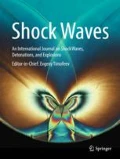Abstract
Critical conditions for the direct initiation of self-sustained detonation in cryogenic hydrogen-oxygen mixtures are examined experimentally. These initial conditions are expected to depend mainly on four parameters: the equivalence ratio of the mixture, the amount of the initial energy deposition, the initial temperature and pressure of the mixture. These critical conditions are determined by fixing alternatively three of these parameters and varying the fourth one from subcritical to supercritical detonation conditions. Results are presented for initial pressuresP o and equivalence ratios Φ ranging from 0.3 to 1 bar and from 1 to 2 respectively, for the two initial temperaturesT o, 123 K and 293 K. These results indicate that for the lowest values of the initial pressure, a decrease of initial temperature may favour the onset of detonation. Whatever the initial conditions, the measured detonation pressures and velocities are in reasonably good agreement with the corresponding Chapman-Jouguet values computed using the ideal-gas equation of state.
Similar content being viewed by others
References
Baker WE, Cox PA, Westine PS, Kulesz JJ, Strehlow RA (1983) Explosion Hazards and Evaluation. Elsevier Scientific Publishing Company
Benedick WB, Guirao CM, Knystautas R, Lee JH (1986) Critical charge for the direct initiation of Detonation in gaseous fuel-air mixtures. AIAA Progress in Astronautics and Aeronautics 106:181–202
Desbordes D (1990) Aspects stationnaires et transitoires de la détonation dans les gaz: relation avec la structure cellulaire du front. Thèse de Docteur es Sciences, Université de Poitiers
Edse R, Lawrence JR (1969) Detonation induction phenomena and flame propagation under cryogenic temperature. Combustion and Rame 13:479–486
Heuzé O (1985) Contribution au calcul des caractéristiques de détonation de substances explosives gazeuses ou condensés. Thèse de l'Université de Poitiers
Kee RJ, Miller JA, Jefferson TH (1989) CHEMKIN: A general-purpose, problem-independent, transportable, fortran chemical kinetics code package. SANDIA REPORT, SAND80-8003.UC-4 (1989).
Kumar RK (1990) Detonation cell widths in hydrogen-oxygen-diluent mixtures. Combustion and Flame 80:157–169
Libouton JC, Dormal M, and Van Tiggelen PJ (1981) Reinitiation process at the end of the detonation cell. Progress in Astronautics and Aeronautics 75 AIAA:358–359
Miller JA, Mitchell RE, Smooke MD, Kee RJ (1982) Towards a comprehensive kinetic mechanism for oxidation of acetylene. 19th Int. Symposium on Combustion:181–196, The Combustion Institute, Pittsburgh, Pa
Mitchell RE, Kee RJ (1989) A general-purpose computer code for predicting chemical kinetic behavior behind incident and reflected shocks. Sandia Report, SAND82-8205, août 1989
Pawel D, Vasatko H, Wagner HGg (1969) The influence of initial temperature on the limits of detonability. Final Scientific Report, Grant of Eoar:67-49, 30 juin
Pedley MD, Bishop CV, Benz FJ, Bennet CA, Mc Clenagan RD, Fenton DL, Knystautas R, Lee JH, Péraldi O, Dupré G, Shepherd JE (1988), Hydrazine vapor detonations, AIAA Progress in Astronautics and Aeronautics 114:45–63
Plaster M, Mc Clenagan RA, Benz F.J., Shepherd JE, Lee JHS (1989) Detonation of cryogenic gaseous hydrogen-oxygen mixtures. Progress in Astronautics and Aeronautics 133 AIAA:37
Sedov LI (1959) Similarity and dimensional methods in mechanics. Academic Press, Inc. NY
Shepherd JE (1959) Chemical Kinetics of Hydrogen-Air Diluent Detonations. AIAA Progress in Astronautics and Aeronautics 106:263–29
Strehlow RA, Maurer RE, Rajan C (1969a) Transverse waves in detonations, I: Spacing in hydrogen-oxygen system. AIAA Journal 7, 2:323–328
Strehlow RA, Engel CD (1969b) Transverse waves in detonations, II: Structure in H2-O2, C2H2-O2, C2H4-O2, and CH4-O2 systems. AIAA Journal, 7, 2:492–496
Vasiliev AA and Grigor'ev VV (1980) Critical conditions for gas detonation in sharply expanding channels. Fiz. Goreniya Vzryva 16:117–125
Zeldovich YaB, Kogarko SM, Simonov NH (1956) Etude expérimentale de la détonation sphérique dans les gaz. Z.E.T.P. 26:1744–1772
Author information
Authors and Affiliations
Rights and permissions
About this article
Cite this article
Zitoun, R., Desbordes, D., Guerraud, C. et al. Direct initiation of detonation in cryogenic gaseous H2-O2 mixtures. Shock Waves 4, 331–337 (1995). https://doi.org/10.1007/BF01413875
Received:
Accepted:
Issue Date:
DOI: https://doi.org/10.1007/BF01413875




